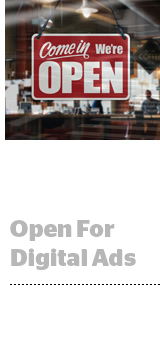
While big brands are slowly shifting their budgets toward digital media, small businesses are fueling the growth of internet ad spend.
Digital will make up more than half of total global ad spend for the first time in 2021 at $350 billion, according to Zenith’s global ad spend forecast, released Monday. Total global ad spend will grow 4.6% in 2019 to reach $639 billion, slightly down from Zenith’s 4.7% growth forecast in March.
Digital is growing thanks in large part to small businesses that otherwise wouldn’t be spending on media at all, said Jonathan Barnard, head of forecasting at Zenith.
“It’s untapped advertisers that have been coming into the market using simple, self-serve tools provided by platforms like Facebook and Google,” he said.
For smaller brands and businesses with annual budgets of less than $10,000, traditional media is too expensive. But these advertisers use digital platforms to target scaled audiences.
“They have a completely different strategy because they have a different budget size,” Barnard said. “Small businesses don’t have the budget that would allow them to conduct the mass awareness campaigns that large advertisers find very valuable.”
Facebook and Google are the biggest beneficiaries of small business advertising. However, it’s impossible to know exactly what percentage of new advertising budgets are flowing to their platforms because they don’t share that information.
“In terms of the number of advertisers on Facebook and Google, [small businesses are] the vast majority,” Barnard said. “A large portion of revenues are coming from these advertisers.”
But as small and digital-native businesses grow, they often turn to TV, out of home and radio to drive mass awareness. Overall, digital ad spend growth will slow from 17% in 2018 to 12% in 2019, eventually stooping to 10% by 2021 as the medium matures.
Still, small business advertisers likely won’t shift all of their budget toward traditional media as they grow, as there are more places to spend online than just a few years ago, Barnard said.
Clinging to tradition
While large, traditional brands are gradually shifting their budgets toward digital, they’re doing so more slowly than small businesses. Most brand advertisers are still spending much less than 50% of their budget in digital channels, Barnard said.
“TV still remains an indispensable part of most advertisers plans and campaigns,” he said.
That will change, however, as TV ratings continue to erode while scarcity keeps prices high. Advertisers are peppering online video – especially long-form video in over-the-top TV – into their media plans to capture shifting consumer viewing habits.
But there’s no scaled replacement for linear TV.
“We expect advertisers to continue spending higher portions of their budget in digital as time goes on,” Barnard said. “As traditional TV’s reach is falling, you can’t get the same effects.”
That’s bad news for the TV networks, which are already selling at a premium and still struggling to make up for the losses they’re facing in the linear business.
“It will become more difficult for them to pay for content and they will face increasing competition with online platforms,” Barnard said.
As SVOD models continue to emerge in streaming, a large portion of TV audiences can’t be reached by advertising. But overall, people are consuming more video than they did a few years ago, which is good for advertisers.
“The market is still expanding,” Barnard said.
This post was syndicated from Ad Exchanger.


More Stories
Chris Clark makes a splash as Surf Filmmaker of the Year
Spotify Is Ready to Compete for Video Advertising
AdGPT Exits Stealth To Create AI-Generated Ads For SMBs